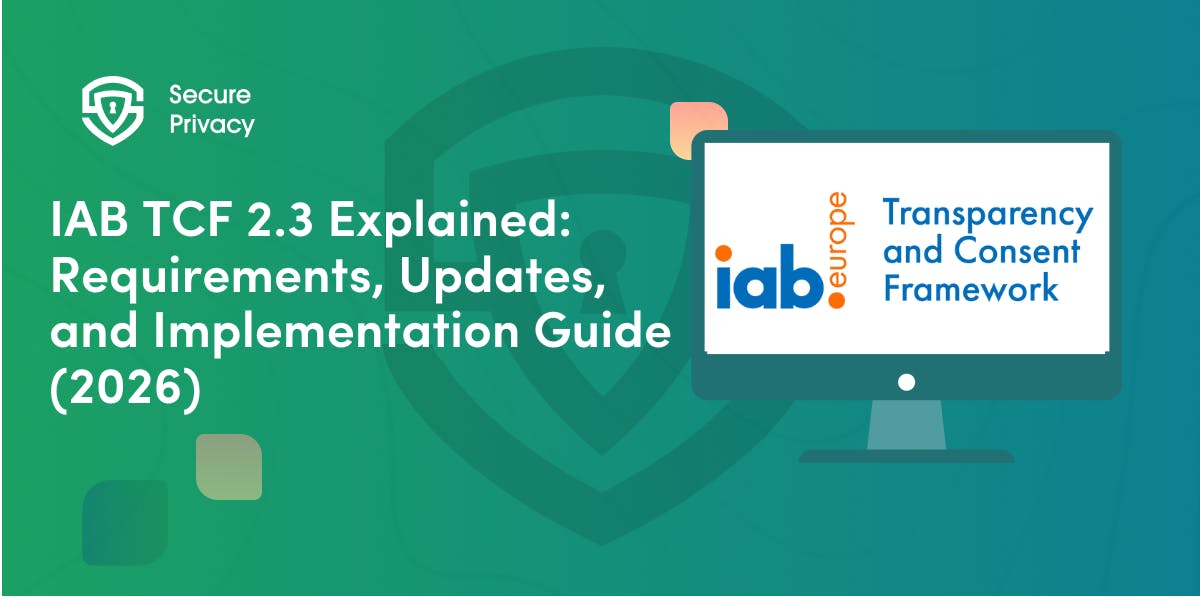The Impact of AI on Consent Management Practices: The Ultimate Guide
The collision of artificial intelligence and privacy regulations has created a new frontier in consent management. Organizations now face unprecedented challenges in balancing technological innovation with user privacy rights. As AI systems become increasingly sophisticated at analyzing and utilizing personal data, traditional consent approaches have quickly become obsolete. This shift isn't merely technical—it represents a fundamental change in the relationship between organizations and individuals, with users now expecting granular control over their digital footprints.
AI Consent Management: An Adaptive Framework
The integration of artificial intelligence into data processing systems has fundamentally transformed how organizations approach consent. Static privacy policies and simple opt-in checkboxes no longer suffice in a world where AI applications continuously learn and adapt to user data. This evolution creates a fascinating paradox: AI simultaneously complicates consent requirements while offering new solutions to manage them.
The relationship between AI and consent flows in both directions. AI systems create complex data processing activities that are challenging to explain in user-friendly terms, yet AI itself is being deployed to enhance consent systems through personalization and adaptability. This symbiotic relationship highlights how AI functions as both problem and solution in the privacy landscape.
User-centricity now dominates the conversation around consent management. Driven by regulations like GDPR and changing consumer expectations, organizations must prioritize transparency and individual control. This shift fundamentally alters the power dynamic between companies and users, placing greater emphasis on meaningful consent experiences that build trust while enabling innovation.
Regulatory Frameworks Governing AI Consent
The European Union has established itself as the global leader in AI regulation with the introduction of the EU AI Act. This landmark legislation, which entered into force in August 2024, creates the world's first comprehensive legal framework specifically addressing artificial intelligence and GDPR consent management requirements.
The EU AI Act employs a risk-based approach that categorizes AI systems based on their potential impact:
- Minimal risk applications face lighter requirements
- Limited risk systems must meet basic transparency standards
- High-risk AI applications in critical sectors require robust consent mechanisms
- Unacceptable risk systems are prohibited entirely
This tiered structure creates varying consent obligations depending on how an AI system might affect individuals. For high-risk applications in healthcare, education, or employment, organizations must implement stringent consent practices that provide users with detailed information and meaningful control options.
The regulatory timeline creates important deadlines for compliance. Provisions related to high-risk AI systems become fully applicable in August 2026, while requirements for general-purpose AI models take effect in August 2025. This phased implementation acknowledges the complexity of adapting consent practices to increasingly sophisticated AI applications.
Stay ahead with our 2026 Privacy Compliance Roadmap.
The EU AI Act builds upon foundations established by GDPR, creating a comprehensive framework emphasizing informed, explicit, and freely given consent. Together, these regulations push organizations toward more sophisticated consent management systems that balance compliance requirements with usability concerns. Regulations across the world, like Mexico's LFPDPPP, have also been recently updated to include AI governance provisions in 2025.
Best Practices for AI Consent Management in 2025
Forward-thinking organizations are implementing advanced consent management practices that go beyond minimum regulatory requirements. These approaches focus on building user trust while enabling responsible AI innovation.
Obtaining truly informed consent requires clear communication about how AI will use personal data. Leading organizations have abandoned complex legal language in favor of straightforward explanations that help users understand the implications of their choices. This transparency builds trust while reducing the risk of regulatory violations.
Granular consent options have become essential in the AI era. Rather than all-or-nothing choices, organizations now offer selective consent for different processing purposes and data types. This approach gives users meaningful control while allowing organizations to continue using AI for approved purposes.
Many organizations have implemented specialized Consent Management Platforms (CMPs) to track preferences systematically. These platforms create centralized repositories of consent records with comprehensive audit trails documenting when and how consent was obtained, modified, or withdrawn. The most advanced implementations use blockchain technology to create immutable records that cannot be altered.
Transparency extends beyond initial consent collection to include ongoing accountability measures. Regular audits, assessments, and robust security protocols ensure AI systems operate within the boundaries of user consent. Some organizations publish transparency reports detailing how their AI systems use personal data, creating additional trust with privacy-conscious users.
The Role of User Control and Transparency in AI Consent
Meaningful user control has become a strategic priority for organizations deploying AI systems. This approach goes beyond initial consent collection to provide ongoing management capabilities. User-friendly dashboards now offer comprehensive views of data usage with simple mechanisms for modifying consent settings. Some organizations leverage AI itself to provide personalized privacy recommendations based on individual preferences.
Data portability reinforces user autonomy by preventing lock-in effects. By enabling individuals to easily export their information between services, organizations acknowledge that meaningful consent includes the right to take one's data elsewhere. This capability creates a more competitive landscape where privacy practices become a key differentiator.
Explaining AI decisions presents particular challenges for consent management. The "black box" nature of many algorithms makes it difficult to provide users with clear explanations of how their data influences outcomes. Organizations are investing in explainable AI techniques that make decision-making more transparent, allowing users to understand how their personal information shapes AI outputs.
"Consent fatigue" has emerged as a recognized challenge as AI systems request permission for numerous data uses. Too many prompts lead users to approve requests without careful consideration, undermining the purpose of consent mechanisms. Organizations are implementing contextual approaches that present consent options at relevant moments rather than overwhelming users with excessive requests.
Technical Implementations of AI Consent Management
The technical infrastructure supporting AI consent has evolved to address unique challenges. Advanced Consent Management Platforms incorporate AI capabilities to personalize privacy experiences and adapt to regulatory changes. These platforms form the backbone of consent operations, providing centralized management tools that integrate across an organization's technology stack.
Data encryption and security measures have become non-negotiable aspects of AI consent architectures. As systems process increasing volumes of sensitive information, organizations implement end-to-end encryption and strict access controls. These protections ensure data is only used according to user consent and remains protected against unauthorized access.
Interoperability between systems enables consistent consent management across different contexts. Government services in New Zealand demonstrate how AI and interoperability combine to create seamlessly connected systems that respect individual privacy choices. This approach allows consent preferences to follow individuals across different departments and service providers without repetitive permission requests.
Managing consent for unstructured data presents significant technical challenges. Unlike structured information in databases, unstructured data—such as documents, images, and audio files—requires sophisticated approaches to consent management. Organizations implement AI-powered classification tools that identify personal information within unstructured data and apply appropriate consent rules throughout complex processing pipelines.
AI Consent Management in Specialized Contexts
Healthcare presents unique challenges and opportunities for AI consent management. Systems analyzing sensitive health information must balance potential benefits with stringent privacy protections. Some providers implement attribute-level consent mechanisms allowing patients to specify exactly which health data points they're comfortable sharing. These systems also support delegation of consent authority, enabling family members to manage permissions for elderly relatives or children when appropriate.
Government services use AI consent practices to transform service delivery while protecting citizen privacy. AI systems analyze individual and community data to identify trends and needs, while interoperable systems ensure resources are allocated efficiently. Advanced consent mechanisms ensure that data used for community initiatives respects individual privacy settings through anonymization or aggregation techniques aligned with citizen preferences.
Financial services require specialized consent approaches due to the sensitivity of personal financial data. AI systems detecting fraud, assessing creditworthiness, or providing investment advice must address heightened security concerns and specific regulatory requirements. Many institutions implement granular options allowing customers to specify exactly which financial information can be used for different AI applications.
Marketing has been transformed by AI capabilities, creating complex consent challenges. Systems analyzing consumer behavior to deliver targeted advertising raise concerns about surveillance and manipulation. Ethical marketing practices go beyond regulatory minimums by clearly explaining how AI uses consumer data and offering straightforward opt-out mechanisms. These approaches recognize that trust provides more long-term value than aggressive data collection practices.
Future Trends in AI Consent Management
Dynamic consent models represent one of the most promising developments in AI consent management. These approaches move beyond static, one-time permission to more flexible systems that adapt to changing contexts and user preferences. Dynamic consent acknowledges that permissions should evolve over time, particularly for AI systems that continuously learn and develop new capabilities.
Federated learning and privacy-preserving techniques are transforming consent management by changing how data is processed. These approaches allow AI models to learn without requiring personal information to be centralized. By keeping data on user devices and sharing only model updates rather than raw information, these techniques reduce privacy risks and simplify consent requirements.
Blockchain integration with consent systems provides immutable records of permission transactions. This technology creates transparent audit trails documenting when and how consent was provided, modified, or withdrawn. Blockchain-based consent registries give users cryptographic proof of their consent status that can be verified independently, increasing trust in the consent process.
Standardized consent frameworks operating across organizations and sectors will simplify compliance and create more consistent user experiences. These frameworks establish common language, technical protocols, and interoperability standards for AI consent management. Development involves collaboration between industry, regulators, and consumer advocates to balance innovation with robust privacy protections.
Ethical Considerations in AI Consent Management
Ethical dimensions of AI consent extend beyond legal compliance to address fundamental questions about autonomy and fairness. The concept of "informed" consent becomes particularly challenging with complex AI systems whose potential applications may not be fully predictable. Organizations must determine what constitutes truly informed consent when future AI uses remain uncertain at the time permission is obtained.
Algorithmic bias represents a significant ethical challenge in consent management. If mechanisms themselves contain biases—by being less accessible to certain groups or by presenting options in subtly influential ways—they undermine the principle of freely given consent. Organizations conduct regular audits of their consent processes to identify and mitigate potential biases across diverse user populations.
"Meaningful choice" has emerged as a central ethical principle in AI consent management. This concept recognizes that consent is only valid when users have genuine alternatives without coercion or manipulation. Organizations evaluate whether their practices offer real choice or merely its illusion, designing consent experiences that respect user autonomy regardless of the decision made.
Power imbalances between individuals and organizations deploying AI systems raise additional ethical concerns. Users often have limited understanding of AI capabilities and minimal bargaining power compared to large organizations. This disparity can undermine voluntary consent, particularly when services are essential or alternatives are scarce. Ethical review boards including diverse stakeholders help ensure consent mechanisms reflect various perspectives rather than simply serving organizational interests.
Exploring the Future of AI Consent
The intersection of artificial intelligence and consent management continues to evolve rapidly. Organizations that implement robust, user-centric consent practices gain competitive advantages through increased trust and reduced regulatory risk. As AI systems become more deeply embedded in critical infrastructure and decision-making processes, effective consent management will remain essential for responsible innovation.
The most successful approaches balance technological capabilities with ethical considerations and regulatory requirements. By providing transparent explanations, meaningful control options, and secure consent infrastructure, organizations can build trust while leveraging AI for legitimate business purposes. This balanced approach recognizes that consent isn't merely a compliance exercise—it's a fundamental mechanism for ensuring AI systems respect individual autonomy.
As we chart this intricate terrain, ongoing dialogue between technologists, ethicists, regulators, and users will shape the future of consent management. The challenges are significant, but so are the opportunities to develop systems that truly serve human values in the age of artificial intelligence.
Get Started For Free with the
#1 Cookie Consent Platform.
No credit card required

DSAR Tools Explained: Best Software for Automating Privacy Requests
You're drowning in data subject access requests. Manual searches through dozens of systems miss regulatory deadlines and expose organizations to fines starting at $2,500 per violation. The solution? DSAR tools — purpose-built software that automates the entire process of responding to data subject access requests, from intake to delivery.
- Legal & News

IAB TCF 2.3 Explained: Requirements, Updates, and Implementation Guide (2026)
Your ad revenue dropped 40% overnight. Google stopped bidding on your inventory. Your DSP partners flagged your traffic as non-compliant. The culprit? An outdated TCF 2.2 consent string after the February 2026 enforcement deadline.
- Legal & News
- Cookie Consent

The SaaS DPA Guide: GDPR Requirements, Subprocessors, and Automation
Your enterprise deal stalled in legal review for three weeks while procurement demands a comprehensive data processing agreement, your legal team scrambles to understand GDPR requirements, and your sales team watches the quarter-end deadline approach with increasing anxiety.
- Legal & News
- Data Protection

